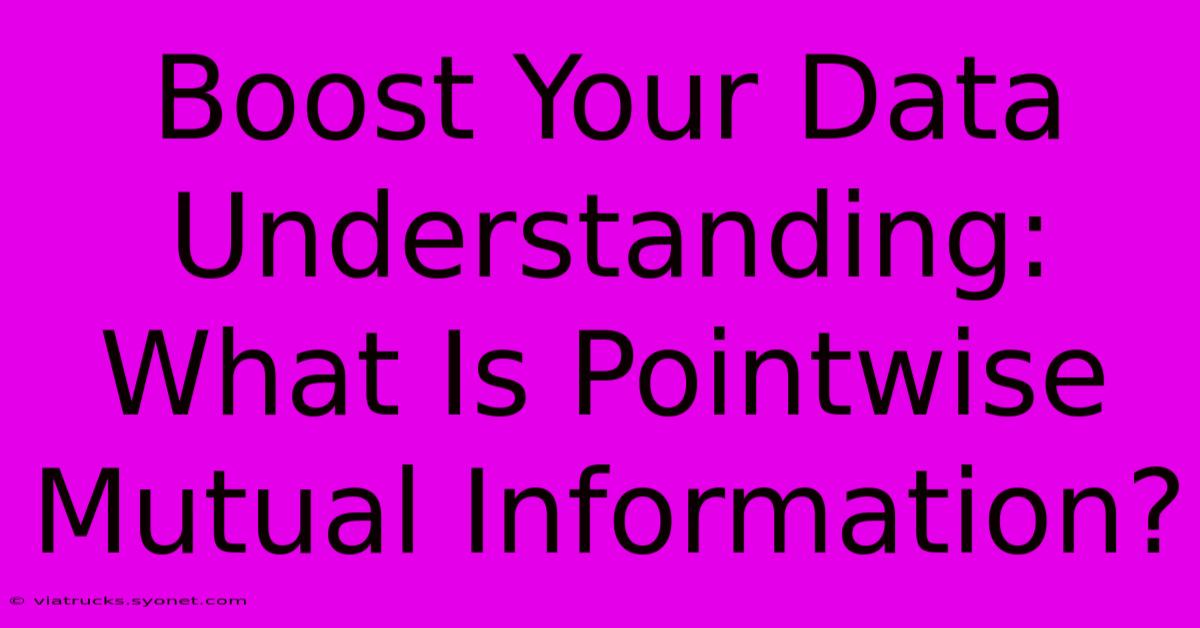Boost Your Data Understanding: What Is Pointwise Mutual Information?

Table of Contents
Boost Your Data Understanding: What is Pointwise Mutual Information (PMI)?
Understanding your data is crucial for any data scientist, analyst, or anyone working with large datasets. One powerful tool for uncovering relationships within data is Pointwise Mutual Information (PMI). This metric quantifies the association between two events, revealing how much knowing about one event changes the probability of the other. This article will delve into what PMI is, how it's calculated, its applications, and its limitations.
What is Pointwise Mutual Information?
In simple terms, PMI measures the dependence between two random variables. A high PMI indicates a strong association – the presence of one variable significantly increases the likelihood of the other. Conversely, a low or negative PMI suggests little to no relationship or even an inverse relationship.
PMI is derived from probability theory. It compares the joint probability of two events (P(X,Y)) to the product of their individual probabilities (P(X) * P(Y)). If the events are independent, the joint probability equals the product of individual probabilities. Any deviation indicates a dependence.
Calculating Pointwise Mutual Information
The formula for calculating PMI is:
PMI(X, Y) = log₂[P(X, Y) / (P(X) * P(Y))]
Where:
- P(X, Y) is the joint probability of events X and Y occurring together.
- P(X) is the probability of event X occurring.
- P(Y) is the probability of event Y occurring.
- log₂ is the base-2 logarithm, resulting in a PMI value measured in bits.
Let's illustrate with an example. Suppose we're analyzing the co-occurrence of words in a text corpus. Let's say:
- P("data", "science") = 0.05 (Probability of "data" and "science" appearing together)
- P("data") = 0.2 (Probability of "data" appearing)
- P("science") = 0.1 (Probability of "science" appearing)
Then:
PMI("data", "science") = log₂(0.05 / (0.2 * 0.1)) ≈ 1.32
A PMI of 1.32 indicates a positive association between "data" and "science". Knowing one word increases the likelihood of encountering the other.
Applications of Pointwise Mutual Information
PMI finds applications in various fields, including:
- Natural Language Processing (NLP): Identifying collocations (words that frequently appear together), improving word embeddings, and text mining.
- Information Retrieval: Improving search relevance by identifying strongly associated terms.
- Bioinformatics: Analyzing gene co-expression and protein-protein interactions.
- Recommendation Systems: Predicting user preferences based on item co-occurrences.
Advantages of using PMI:
- Simplicity: The concept and calculation are relatively straightforward.
- Interpretability: The logarithmic scale provides a clear interpretation of the strength and direction of the association.
- Flexibility: Applicable to various data types and domains.
Limitations of using PMI:
- Sparsity: PMI can be highly sensitive to sparse data. If the joint probability is zero, PMI is undefined (though this can be addressed through smoothing techniques).
- Bias towards infrequent events: Rare events can have artificially high PMI scores due to low denominators.
- Doesn't capture all types of relationships: PMI only captures the linear association between events and can't fully model complex interactions.
Beyond Pointwise Mutual Information
While PMI is a valuable tool, it's crucial to be aware of its limitations. Researchers often employ alternative or complementary methods such as Normalized Pointwise Mutual Information (NPMI), which mitigates some of the bias issues associated with PMI. Understanding these limitations and exploring other association measures is key to drawing accurate conclusions from your data analysis.
Conclusion
Pointwise Mutual Information is a powerful and versatile metric for uncovering relationships within data. By understanding its calculation, applications, and limitations, you can significantly boost your data understanding and unlock valuable insights from your datasets. Remember to consider the context of your data and explore complementary methods to gain a more comprehensive understanding of the relationships within your data. Using PMI effectively, along with other analytical techniques, will help you extract richer information and improve the accuracy of your analysis.

Thank you for visiting our website wich cover about Boost Your Data Understanding: What Is Pointwise Mutual Information?. We hope the information provided has been useful to you. Feel free to contact us if you have any questions or need further assistance. See you next time and dont miss to bookmark.
Featured Posts
-
Lost And Found On The Irt A Gripping Tale
Feb 09, 2025
-
Struggling To Remember Giants Nicknames Problem Solved
Feb 09, 2025
-
Beyond Scrooge Discover George C Scotts Chilling Carol
Feb 09, 2025
-
Austin Reaves Lakers Win Over Pacers
Feb 09, 2025
-
Supporting Artists This Video Contains Content From Sesac
Feb 09, 2025
